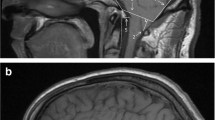Abstract
Background
When the neck is flexed in patients with Chiari I malformation, herniated tonsils descend, impacting the spinal canal, and the clivus-canal angle changes and compresses the ventral spinal cord. Therefore, we speculated that the existence of tonsillar herniation might have some influence on the cervical spine, such as changes in range of motion, sagittal alignment, and spondylosis. The purpose of this radiological study was to clarify quantitatively the relation between tonsillar herniation and the cervical spine regarding range of motion, sagittal alignment, and cervical spondylotic change.
Methods
We examined the cervical spine of 609 outpatients with magnetic resonance imaging, and the cerebral tonsils being located below the foramen magnum was defined as tonsillar herniation. Of the 609 patients, 88 (14.4%) had tonsillar herniation. Two of the 88 patients who had complicating osseous anomalies were excluded from this study, and the remaining 86 patients with tonsillar herniation were the subject group (TH group). Of the remaining 521 patients without tonsillar herniation, 86 patients whose age and sex matched those of the TH group were selected at random to be in the control group (Non-TH group). The range of motion, sagittal alignment, and the diameter of the intersegmental dura in the cervical spine in the TH group were compared by age with those in the Non-TH group using a roentgenograph or magnetic resonance imaging.
Results
The range of motion at C1-C2 was significantly smaller in the TH group (5.4°) than in the Non-TH group (8.4°) in patients over 70 years of age. The level of narrowing of the dura diameter at C5/C6 was significantly higher (P = 0.029) in the TH group (23.3%) than in the Non-TH group (13.4%) in patients over 70 years of age. The cervical alignment was similar in both groups for all age groups.
Conclusions
The existence of tonsillar herniation was associated with loss of range of motion at the upper cervical spine and progression of spondylotic change, especially in elderly patients.
Similar content being viewed by others
References
GN Dyste AH Menezes (1988) ArticleTitlePresentation and management of pediatric Chiari malformations without myelodysplasia Neurosurgery 23 589–97 Occurrence Handle10.1097/00006123-198811000-00008 Occurrence Handle1:STN:280:DyaL1M%2FntVygsg%3D%3D Occurrence Handle3200390
GN Dyste AH Menezes JC VanGilder (1989) ArticleTitleSymptomatic Chiari malformations. An analysis of presentation, management, and long-term outcome J Neurosurg 71 159–68 Occurrence Handle10.3171/jns.1989.71.2.0159 Occurrence Handle1:STN:280:DyaL1MzhtVOjtw%3D%3D Occurrence Handle2746341
V Nohria WJ Oakes (1990) ArticleTitleChiari I malformation: a review of 43 patients Pediatr Neurosurg 16 222–7 10.1159/000120531 Occurrence Handle10.1159/000120531 Occurrence Handle2135191
MG Nagib (1994) ArticleTitleAn approach to symptomatic children (ages 4–14 years) with Chiari type I malformation Pediatr Neurosurg 21 31–5 Occurrence Handle10.1159/000120811 Occurrence Handle1:STN:280:DyaK2M%2FjsVaqsA%3D%3D Occurrence Handle7947307
S Tachibana H Iida K Yada (1992) ArticleTitleSignificance of positive Queckenstedt test in patients with syringomyelia associated with Arnold-Chiari malformations J Neurosurg 76 67–71 10.3171/jns.1992.76.1.0067 Occurrence Handle10.3171/jns.1992.76.1.0067 Occurrence Handle1:STN:280:DyaK38%2FnvFSntg%3D%3D Occurrence Handle1727171
WRK Smoker (1994) ArticleTitleCraniovertebral junction: normal anatomy, craniometry, and congenital anomalies Radiographics 14 255–77 Occurrence Handle1:STN:280:DyaK2c3kvVertA%3D%3D Occurrence Handle8190952
JJ Bartko (1966) ArticleTitleThe intraclass correlation coefficient as a measure of reliability Psychol Rep 19 3–11 Occurrence Handle1:STN:280:DyaF287mtVertw%3D%3D Occurrence Handle5942109
AD Elster MYM Chen (1992) ArticleTitleChiari I malformations: clinical and radiologic reappraisal Radiology 183 347–53 Occurrence Handle1:STN:280:DyaK383itV2lsw%3D%3D Occurrence Handle1561334
RA Armonda CM Citrin KT Foley RG Ellenbogen (1994) ArticleTitleQuantitative cine-mode magnetic resonance imaging of Chiari I malformations: an analysis of cerebrospinal fluid dynamics Neurosurgery 35 214–24 Occurrence Handle10.1097/00006123-199408000-00006 Occurrence Handle1:STN:280:DyaK2M%2FlvFynuw%3D%3D Occurrence Handle7969828
RA Bhadelia AR Bogdan SM Wolpert S Lev BA Appignani CB Heilman (1995) ArticleTitleCerebrospinal fluid flow waveforms: analysis in patients with Chiari I malformation by means of gated phase-contrast MR imaging velocity measurements Radiology 196 195–202 Occurrence Handle1:STN:280:DyaK2MzgsVShtg%3D%3D Occurrence Handle7784567
J Pujol C Roig A Capdevila A Pou JL Martí-Vilalta J Kulisevsky et al. (1995) ArticleTitleMotion of the cerebellar tonsils in Chiari type I malformation studied by cine phase-contrast MRI Neurology 45 1746–53 Occurrence Handle1:STN:280:DyaK2MvgsFKguw%3D%3D Occurrence Handle7675239
TH Milhorat MW Chou EM Trinidad RW Kula M Mandell C Wolpert et al. (1999) ArticleTitleChiari I malformation redefined: clinical and radiographic findings for 364 symptomatic patients Neurosurgery 44 1005–17 10.1097/00006123-199905000-00042 Occurrence Handle10.1097/00006123-199905000-00042 Occurrence Handle1:STN:280:DyaK1M3kslCqtg%3D%3D Occurrence Handle10232534
JCY Cheng WW Chau X Guo YL Chan (2003) ArticleTitleRedefining the magnetic resonance imaging reference level for the cerebellar tonsil. A study of 170 adolescents with normal versus idiopathic scoliosis Spine 28 815–8 10.1097/00007632-200304150-00015 Occurrence Handle10.1097/00007632-200304150-00015 Occurrence Handle12698126
Author information
Authors and Affiliations
About this article
Cite this article
Takeuchi, K., Yokoyama, T., Ito, J. et al. Tonsillar herniation and the cervical spine: a morphometric study of 172 patients. J Orthop Sci 12, 55–60 (2007). https://doi.org/10.1007/s00776-006-1089-7
Received:
Accepted:
Published:
Issue Date:
DOI: https://doi.org/10.1007/s00776-006-1089-7




